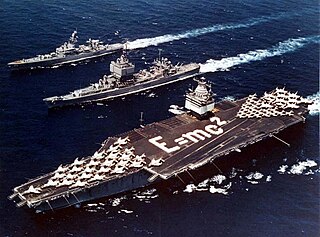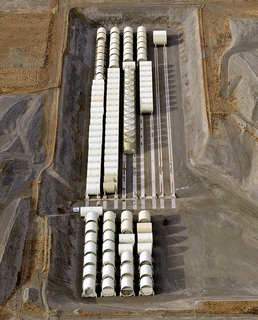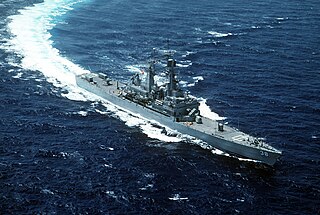 W
WNuclear marine propulsion is propulsion of a ship or submarine with heat provided by a nuclear power plant. The power plant heats water to produce steam for a turbine used to turn the ship's propeller through a gearbox or through an electric generator and motor. Naval nuclear propulsion is used specifically within naval warships such as supercarriers. A small number of experimental civil nuclear ships have been built.
 W
WThe United States Navy at one time had nuclear-powered cruisers as part of its fleet. The first such ship was USS Long Beach (CGN-9). Commissioned in late summer 1961, she was the world's first nuclear-powered surface combatant. She was followed a year later by USS Bainbridge (DLGN-25). While Long Beach was a 'true cruiser', meaning she was designed and built as a cruiser, Bainbridge began life as a frigate, though at that time the Navy was using the hull code "DLGN" for "destroyer leader, guided missile, nuclear". This was prior to the enactment of the 1975 ship reclassification plan, in which frigates (DLG/DLGN),, were reclassified as cruisers, so that the US Navy's numbers would compete with those of the Soviet Navy. Long Beach, the largest of all the nuclear cruisers, was equipped with a C1W cruiser reactor, while all the others were equipped with D2G destroyer reactors.
 W
WA strike cruiser was a proposal from DARPA for a class of cruisers in the late 1970s. The proposal was for the Strike Cruiser to be a guided missile attack cruiser with a displacement of around 17,200 long tons (17,500 t), armed and equipped with the Aegis combat system, the SM-2, Harpoon anti-ship missile, the Tomahawk missile, and the Mk71 8-inch gun.
 W
WUnited States naval reactors are nuclear reactors used by the United States Navy aboard certain ships to generate the steam used to produce power for propulsion, electric power, catapulting airplanes in aircraft carriers, and a few more minor uses. Such naval nuclear reactors have a complete power plant associated with them. All U.S. Navy submarines and supercarriers built since 1975 are nuclear-powered by such reactors. There are no commissioned conventional (non-nuclear) submarines or aircraft carriers left in the U.S. Navy, since the last conventional carrier, USS Kitty Hawk, was decommissioned in May 2009. The U.S. Navy had nine nuclear-powered cruisers with such reactors also, but they have since been decommissioned. Reactors are designed by a variety of contractors, then developed and tested at one of several government owned and prime contractor-operated facilities: Bettis Atomic Power Laboratory in West Mifflin, Pennsylvania and its associated Naval Reactors Facility in Idaho, and Knolls Atomic Power Laboratory in Niskayuna, New York and its associated Kesselring site in West Milton, New York, all under the management of the office of Naval Reactors. Sometimes there were full-scale nuclear-powered prototype plants built at the Naval Reactors Facility, Kesselring, and Windsor to test the nuclear plants, which were operated for years to train nuclear-qualified sailors.
 W
WCaptain John Henry Ebersole, M.D., MC USN a pioneer in submarine medicine and radiation oncology, selected by Admiral Hyman G. Rickover to serve as medical officer aboard the US Navy's first two nuclear powered submarines, the USS Nautilus and the USS Seawolf. He was the radiologist for NASA that screened the Mercury Seven astronauts for Project Mercury. Ebersole was the radiologist responsible for the x-rays taken during the autopsy of John F. Kennedy on 22 November 1963 at Bethesda Naval Medical Center.
 W
WUSS Abraham Lincoln (CVN-72) is the fifth Nimitz-class aircraft carrier in the United States Navy. She is the second Navy ship to have been named after the former President Abraham Lincoln. Her home port is NAS North Island, and she is a member of the United States Pacific Fleet. She is administratively responsible to Commander, Naval Air Forces Pacific, and operationally served as the flagship of Carrier Strike Group Nine and host to Carrier Air Wing Two until 2012. She was returned to the fleet on 12 May 2017, marking the successful completion of her refueling and complex overhaul carried out at Newport News Shipyard. On 5 May 2019 USS Abraham Lincoln was deployed to the Middle East as the flagship for Carrier Strike Group 12 and Carrier Air Wing Seven assigned to her.
 W
WUSS Arkansas (CGN-41) was a Virginia-class nuclear-propelled guided-missile cruiser of the U.S. Navy. She was in commission from October 1980 through July 1998. Her primary missions were in defending aircraft carrier task forces in air defense (AAW) and antisubmarine warfare (ASW) by using her guided missiles, radar systems, and sonar systems. Since Arkansas had the high speed and unlimited range provided by her nuclear reactors, she usually escorted the nuclear-powered aircraft carriers of the U.S. Navy.
 W
WUSS Bainbridge (DLGN-25/CGN-25) was a nuclear-powered guided missile cruiser in the United States Navy, the only ship of her class. Named in honor of Commodore William Bainbridge, she was the fourth US Navy ship to bear the name. With her original hull classification symbol of DLGN, she was the first nuclear-powered destroyer-type ship in the US Navy, and shared her name with the lead ship of the first US Navy destroyer class, the Bainbridge-class destroyers.
 W
WUSS California (CGN-36), the lead ship of the California-class of nuclear-powered guided missile cruisers, was the sixth warship of the United States Navy to be named for the State of California.
 W
WUSS Carl Vinson (CVN-70) is the United States Navy's third Nimitz-class supercarrier. She is named for Carl Vinson, a Congressman from Georgia, in recognition of his contributions to the U.S. Navy. The ship was launched in 1980, undertook her maiden voyage in 1983, and underwent refueling and overhaul between 2005 and 2009.
 W
WUSS Dwight D. Eisenhower (CVN-69) is a nuclear-powered aircraft carrier currently in service with the United States Navy. Commissioned in 1977, the ship is the second of the ten Nimitz-class aircraft carriers currently in service, and is the first ship named after the 34th President of the United States and General of the Army Dwight D. Eisenhower. The vessel was initially named simply as USS Eisenhower, much like the lead ship of the class, Nimitz, but the name was changed to its present form on 25 May 1970. The carrier, like all others of her class, was constructed at Newport News Shipbuilding Company in Virginia, with the same design as the lead ship, although the ship has been overhauled twice to bring her up to the standards of those constructed more recently.
 W
WUSS Enterprise (CVN-65), formerly CVA(N)-65, is a decommissioned United States Navy aircraft carrier. She was the first nuclear-powered aircraft carrier and the eighth United States naval vessel to bear the name. Like her predecessor of World War II fame, she is nicknamed "Big E". At 1,123 feet (342 m), she is the longest naval vessel ever built. Her 93,284-long-ton (94,781 t) displacement ranks her as the 12th-heaviest carrier, after the ten carriers of the Nimitz class and USS Gerald R. Ford. Enterprise had a crew of some 4,600 service members.
 W
WUSS George H.W. Bush (CVN-77) is the tenth and final Nimitz-class supercarrier of the United States Navy. She is named for the 41st President of the United States and former Director of Central Intelligence George H. W. Bush, who was a naval aviator during World War II. The vessel's callsign is Avenger, after the TBM Avenger aircraft flown by then-Lieutenant George H.W. Bush in World War II. Construction began in 2003 at the Northrop Grumman Newport News shipyard's Dry Dock 12, the largest in the western hemisphere. She was completed in 2009 at a cost of $6.2 billion and her home port is Naval Station Norfolk, Virginia.
 W
WUSS George Washington (CVN-73) is a United States Navy nuclear-powered aircraft carrier, the sixth carrier in the Nimitz class and the fourth US Navy ship named after George Washington, commander-in-chief of the Continental Army during the American Revolutionary War and the first president of the United States. The contract for George Washington was awarded to Newport News Shipbuilding on 27 December 1982. Her keel was laid on 25 August 1986, she was christened on 21 July 1990 by First Lady Barbara Bush, and she was commissioned at Naval Station Norfolk on 4 July 1992.
 W
WUSS Gerald R. Ford (CVN-78) is the lead ship of her class of United States Navy aircraft carriers. The ship is named after the 38th President of the United States, Gerald Ford, whose World War II naval service included combat duty aboard the light aircraft carrier Monterey in the Pacific Theater.
 W
WUSS Harry S. Truman (CVN-75) is the eighth Nimitz-class aircraft carrier of the United States Navy, named after the 33rd President of the United States, Harry S. Truman. The ship's callsign is Lone Warrior, and she is currently homeported at Naval Station Norfolk, Virginia.
 W
WUSS John C. Stennis (CVN-74) is the seventh Nimitz-class nuclear-powered supercarrier in the United States Navy, named for Democratic Senator John C. Stennis of Mississippi.
 W
WUSS Long Beach (CLGN-160/CGN-160/CGN-9) was a nuclear-powered guided missile cruiser in the United States Navy and the world's first nuclear-powered surface combatant. She was the third Navy ship named after the city of Long Beach, California.
 W
WUSS Mississippi (CGN-40), a Virginia-class nuclear powered guided-missile cruiser, was the fourth ship of the United States Navy named in honor of the 20th state admitted to the Union. Her keel was laid down by the Newport News Shipbuilding and Drydock Company at Newport News, Virginia, on 22 February 1975. She was launched on 31 July 1976. The ship was commissioned on 5 August 1978 by Jimmy Carter, then serving as the 39th President of the United States. Early deployment included escorting the carrier USS Nimitz (CVN-68). She also was deployed in 1989 as a response to the capture and subsequent murder of U.S. Marine Corps Colonel William R. Higgins by terrorists.
 W
WUSS Nimitz (CVN-68) is a supercarrier of the United States Navy, and the lead ship of her class. One of the largest warships in the world, she was laid down, launched, and commissioned as CVAN-68, "aircraft carrier, attack, nuclear powered", but she was later redesignated as CVN-68, "aircraft carrier, multi-mission, nuclear-powered", on 30 June 1975, as part of a fleet-wide realignment that year.
 W
WUSS Ronald Reagan (CVN-76) is a Nimitz-class, nuclear-powered supercarrier in the service of the United States Navy. As the ninth ship of her class, she's named in honor of Ronald W. Reagan, President of the United States from 1981 to 1989.
 W
WUSS South Carolina (CGN-37) was the second ship of the California class of nuclear-powered guided missile cruisers in the United States Navy.
 W
WUSS Texas (DLGN/CGN-39) was the United States Navy's second Virginia-class nuclear guided missile cruiser. She was the third ship of the Navy to be named in honor of the State of Texas. Her keel was laid down on 18 August 1973, at Newport News, Virginia, by the Newport News Shipbuilding and Drydock Company.
 W
WUSS Theodore Roosevelt (CVN-71) is the fourth Nimitz-class, nuclear-powered, aircraft carrier in the United States Navy. She is named in honor of Theodore Roosevelt, the 26th President of the United States and a proponent of naval power. She is the fourth ship named in honor of Theodore Roosevelt, three bearing his full name and a fourth with just his last name. Another three U.S. Navy ships have "Roosevelt" in their names in honor of members of the Roosevelt family. This carrier's radio call sign is "Rough Rider", the nickname of President Roosevelt's volunteer cavalry unit during the Spanish–American War. She was launched in 1984, and saw her first action during Operation Desert Storm in 1991.
 W
WThe fifth USS Truxtun (DLGN-35/CGN-35) was a nuclear powered cruiser in the U.S. Navy. She was launched as a destroyer leader and later reclassified as a cruiser. She was named after Commodore Thomas Truxtun (1755–1822). She was in service from May 1967 to September 1995.
 W
WUSS Virginia (CGN-38) was a nuclear-powered guided missile cruiser, the lead ship of her class, and the eighth ship of the United States Navy to be named for the Commonwealth of Virginia. She was commissioned in 1976 and decommissioned in 1994.